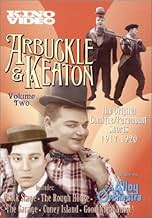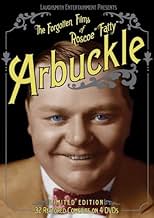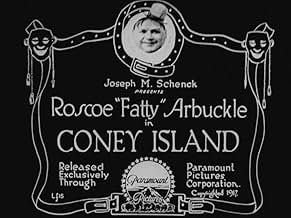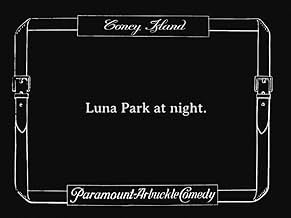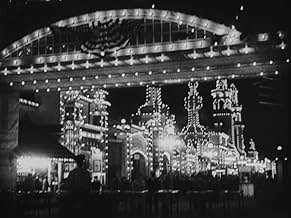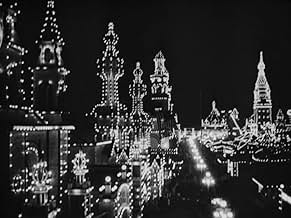NOTE IMDb
6,3/10
1,9 k
MA NOTE
Ajouter une intrigue dans votre langueRoscoe tries to dump his wife so he can enjoy the beach attractions. Buster arrives with Alice, who is taken away from him by Al, who loses her to Roscoe. Bathing beauties and Keystone Kops ... Tout lireRoscoe tries to dump his wife so he can enjoy the beach attractions. Buster arrives with Alice, who is taken away from him by Al, who loses her to Roscoe. Bathing beauties and Keystone Kops abound.Roscoe tries to dump his wife so he can enjoy the beach attractions. Buster arrives with Alice, who is taken away from him by Al, who loses her to Roscoe. Bathing beauties and Keystone Kops abound.
Buster Keaton
- Rival
- (non crédité)
- …
Joe Bordeaux
- Sledgehammer Man
- (non crédité)
- …
Jimmy Bryant
- Undetermined Role
- (non crédité)
Luke the Dog
- Dog Digging on Beach
- (non crédité)
Alice Lake
- Girl at Vanity Table
- (non crédité)
Alice Mann
- Pretty Girl
- (non crédité)
Agnes Neilson
- Fatty's Wife
- (non crédité)
Al St. John
- Old Friend of Fatty's Wife
- (non crédité)
Histoire
Le saviez-vous
- AnecdotesThe Witching Waves ride consisted of a large oval course with a flexible metal floor. The floor itself did not move but an undulating wave, produced by hidden reciprocating levers, propelled two seated scooter-style cars which could be steered by the riders. It was invented by the same man who also invented the revolving door, Theophilus Van Kannel.
The ride can also be seen in the silent movie "Speedy" starring Harold Lloyd.
- GaffesThe first title screen wrongly identifies Coney Island's Luna Park as 'Luma Park'. At 00:03:52 the entrance to Luna Park is clearly seen.
- Citations
Bathing suit renter: [to Fatty] We can't fit you, hire a tent.
- Versions alternativesIn 2005, Laughsmith Entertainment, Inc. copyrighted a 25-minute version of this film, with a new piano music score composed and performed by Philip Carli.
- ConnexionsFeatured in The Great Stone Face (1968)
Commentaire à la une
If you enjoy low comedy, i.e. low to the point of downright crudity, with plenty of slapstick, strenuous mugging, cross-dressing, and general anarchy -- Congratulations, you've come to the right place! The two-reel comedy known as "Coney Island" is a prime example of the sort of rough-housing that made Roscoe Arbuckle one of the top comedians of his era, second only to Chaplin in popularity. It's also a good example of the kind of comedy Arbuckle would soon outgrow, thanks at least in part to his newfound colleague Buster Keaton, who influenced Roscoe to employ more low-key and sophisticated comedic elements in his work. But that would come later. Here, in this early appearance, Buster overacts as shamelessly as everyone else, uncharacteristically grinning, laughing, and even indulging in Stan Laurel-style weeping. In addition to his prominent role as Alice Mann's escort, Buster doubles as mustachioed policeman in the movie's climax (he's the cop relieved of his trousers by Roscoe in the jail house), and also acts as Alice's stunt double in the water slide sequence. They sure did keep the guy busy.
Like so many comedies of its era, this one is built around escalating rivalries over a pretty girl. Initially, Buster is Alice's Coney Island date, but he loses her to creepy Al St. John -- how humiliating! -- who in turn loses her to Roscoe, who must first ditch his homely wife. After various shenanigans at the amusement park Roscoe and Alice wind up at the beach, where they must "hire" bathing suits, and this is where things turn a little strange. Seeing as how there are no men's swim trunks on hand large enough to fit him, Roscoe pilfers and dons a lady's XXX-tra large swimsuit instead. Alice, who doesn't seem to find this turn of events the least bit odd, helpfully finds him a curly wig to wear. Roscoe is in drag for the rest of the film, even when flirting with yet another girl who crosses his path. Somehow, when Arbuckle performs this kind of shtick it's not only amusing but strangely innocent, which is not to say there aren't some weird undercurrents. Anyhow, it all ends in wild mayhem at the jail house, leaving the viewer exhilarated and a little dazed.
This is primitive stuff all right, but it has a number of things in its favor. When the film was made the star comics were young and healthy, and had every reason to expect bright futures ahead. Their exuberance comes across strongly. (I happened to watch this film back-to-back with a short comedy called The Railrodder which Keaton made in Canada more than 45 years later; the contrast between the grinning, muscular 21 year-old Buster we see here and the grizzled, exhausted yet still game old man he would become was harrowing and poignant.) In this Coney Island romp everyone is buff, happy, and full of mischief, and they look like they're having a blast.
For that matter, Coney Island itself looks pretty spiffy here and boasts some really cool looking rides, and that's another plus. This film serves as a historical record of the legendary amusement park in its prime, and it features several great shots that have turned up in various documentaries about the place. The Coney Island of 1917 looks almost as clean and well maintained as the Disney theme parks of today, and this too is poignant: I happened to visit Coney Island myself a couple of years ago, and I'm sorry to say it's not such a cheery place anymore. The only way to visit that bright and happy Coney Island, vicariously anyway, is by seeing this film.
Like so many comedies of its era, this one is built around escalating rivalries over a pretty girl. Initially, Buster is Alice's Coney Island date, but he loses her to creepy Al St. John -- how humiliating! -- who in turn loses her to Roscoe, who must first ditch his homely wife. After various shenanigans at the amusement park Roscoe and Alice wind up at the beach, where they must "hire" bathing suits, and this is where things turn a little strange. Seeing as how there are no men's swim trunks on hand large enough to fit him, Roscoe pilfers and dons a lady's XXX-tra large swimsuit instead. Alice, who doesn't seem to find this turn of events the least bit odd, helpfully finds him a curly wig to wear. Roscoe is in drag for the rest of the film, even when flirting with yet another girl who crosses his path. Somehow, when Arbuckle performs this kind of shtick it's not only amusing but strangely innocent, which is not to say there aren't some weird undercurrents. Anyhow, it all ends in wild mayhem at the jail house, leaving the viewer exhilarated and a little dazed.
This is primitive stuff all right, but it has a number of things in its favor. When the film was made the star comics were young and healthy, and had every reason to expect bright futures ahead. Their exuberance comes across strongly. (I happened to watch this film back-to-back with a short comedy called The Railrodder which Keaton made in Canada more than 45 years later; the contrast between the grinning, muscular 21 year-old Buster we see here and the grizzled, exhausted yet still game old man he would become was harrowing and poignant.) In this Coney Island romp everyone is buff, happy, and full of mischief, and they look like they're having a blast.
For that matter, Coney Island itself looks pretty spiffy here and boasts some really cool looking rides, and that's another plus. This film serves as a historical record of the legendary amusement park in its prime, and it features several great shots that have turned up in various documentaries about the place. The Coney Island of 1917 looks almost as clean and well maintained as the Disney theme parks of today, and this too is poignant: I happened to visit Coney Island myself a couple of years ago, and I'm sorry to say it's not such a cheery place anymore. The only way to visit that bright and happy Coney Island, vicariously anyway, is by seeing this film.
Meilleurs choix
Connectez-vous pour évaluer et suivre la liste de favoris afin de recevoir des recommandations personnalisées
Détails
- Durée25 minutes
- Mixage
- Rapport de forme
- 1.33 : 1
Contribuer à cette page
Suggérer une modification ou ajouter du contenu manquant

Lacune principale
By what name was Fatty à la fête foraine (1917) officially released in Canada in English?
Répondre
